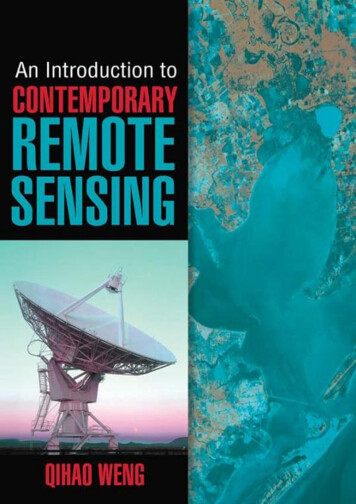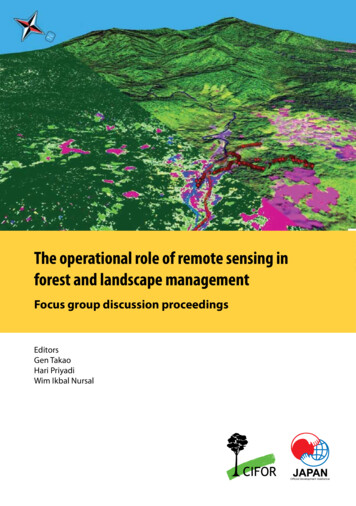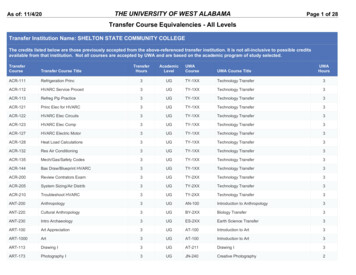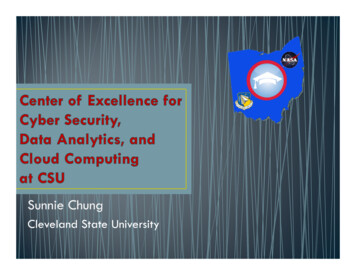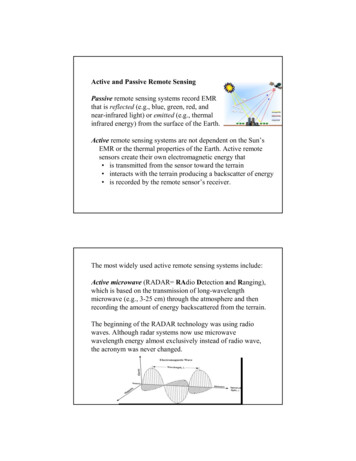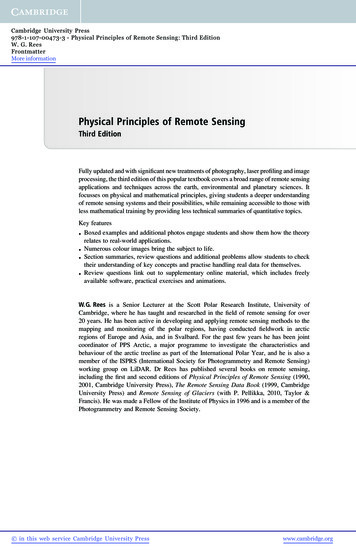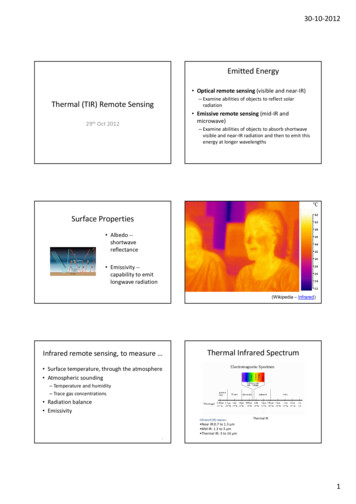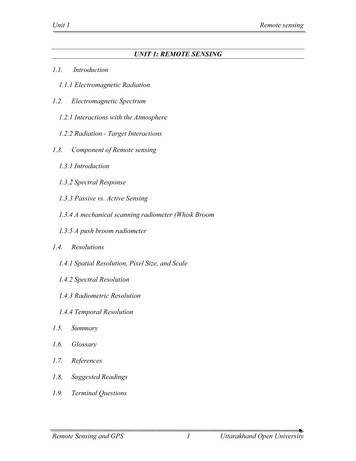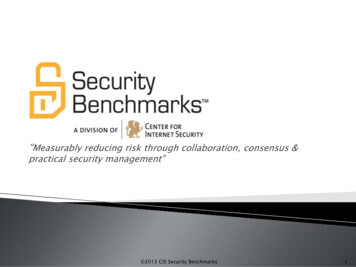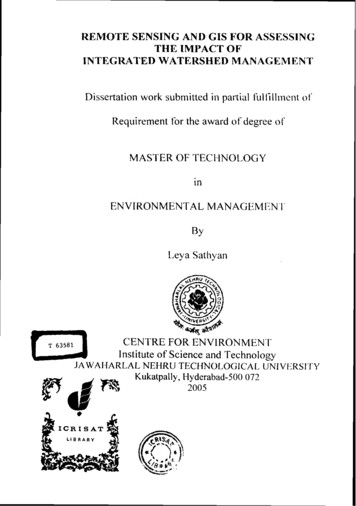
Transcription
REMOTE SENSING AND CIS FOR ASSESSINGTHE IMPACT OFINTEGRATED WATERSHED MANAGEMENTDissertation work submitted in partial ti llill ncntof'Requirement for the award o f dcgree 01'MASTER 01 'fECHNO1,OGYinF NVIRONMENTALMANAGIJILII N1RyL,eya SathyanT 63581CENT RE FOR ENVIRONM'N 1Institute of Science and Technology.IAWAI IARLAI, NEHRU TECt-(NOI,OGICALIJNIVI.RS1 I YKukatpally, tlyderabad-500 0722005
4ICRISATaad3@ACGl ARCent rInternational Crops Research Institute for the Semi-Arid TropicsT d.4Headquarters: Palancheru 502 324, Andhra Prddosh Indl3Fax Ql40 30713074 .I UO 307l30,5 Emdl crts8t@cg arorg4030ll3071 l a l s a nOftrce-CG Centers Rlork NASC Co nplcx c ProkacnvShsstri a r qN?.V Drlhl 110 012 1hdi.iTo1 191 1 1 25H48552'2584255Yi5R49554 Fax 191 1 1 25811784lClllIIIL8lrnlrrL,,,UII *,I,I"It","PCYnil",."7-1.a5l iii:,,ll,lm,,wFar,zb2 TOflB8I",.,,u,r,lr*"quj,n"(WitUSLIIIIIUIPYI'Y O I N l ll &l.FP,IIN":)*.,O,.lm,l,Pl sV. lo*,,WIMI"-wunI*r.wrurnqv.nBI1YITLI, C i , S i ' NaliOl,(n.PDn*,*YllEl*,PIR,.II*hilObl%",, ,I.,-M1(611*1r.Im.,lu. r "nn,r",a,l,at www.lcnrat.org.,A.I.,,,.1 5.,-,(,Im., , , .,, ,.,.c'.?'?7',rri.ICRIIIT*IM.I, *,o"**YI*CI,"8ibii(h,,- N,*r,".,lur, ,a ? .,,r*,. I?Far12,181119Irn.l C"lll.C IILII--
CENTRE FOR ENVIRONMENTINSTITUTE OF SCIENCE 8 TECHNOLOGYJAWAHARLAL NEHRU TECHNOLOGICAL UNIVERSITYKukatpally. Hyderabad - 500 072Dr.P.MNKATESWARLUPh.0.Associate ProfessorCERTIFICATEThls is to certify that the dissertation work enbtled " REMOTE SENSING ANAGEMENT " submitted by LEYA SATHYAN in partla1 fulfillment for the award ofMaster of Technology in Environmental Management to JAWAHARLAL NEHRUTECHNOLOGICAL UNIVERSITY, Hyderabad. ItISa record of bonafide work carr edout by her under my Internal Guidance Her work is found to be satisfactoryThe result embodied In this d ssertation have not been submitted to anyUniversity or Institute for the award of any degree or diploma
INSTITUTE OF SCIENCE 8 TECHNOLOGYJAWAHARLAL NEHRU TECHNOLOGICAL UNNERSITYKukatpally, Hyderabad - 500 072I / W u ccrtil) that t l cdi \eTtiltio iworh untitled "REMOTE SENSING AND GIsFOR ASSESSING THE IMPACT OF INTEGRATED WATERSHED MANAGEMENT"suhmittcd hy 1.E:YA S A T l l Y A N i n partial l'ullillmcntthc M; \tcr I-I'cchnolog 1)cga-cc o f the I)cpnrtincrit i, n hori:ilidc \ \ ( r h .and #nay be placcdhcfbrc the I.xaani ialic)nIsoard li,r their c ,n ideratic)n.
'fhc dissel-tation work entitled "IZEM )I'E SENSING A N D ;IS FORASSESSINGTHEMANAGEMENT"IMI'A :.I' OFhasbeenINTEGRATED WATEIZSHEI)carriedoutbymcatI 'I ISA.I',I':rtancl cru,llytlcraI ad,Indi: and NItSA, 13alanagar, llytlclabatl, Indi: .I'llis work is original and Iias bccn submitted to any university or instit tcfbr the award of any degree.
Wit11 deep sonsc o f hc;lrtlLll gratitude. I \\auld like to acknoaledgc I)r.S.P.WANI,I'rincipal Scientist (Watersheds), ICIIISA'I', I ' a l a s c l i a r Hytlcrabad.I;I giving mc theopportu ity.his hilid help. l SUFFCS OIIZo h l cCIIO ITIOLISP;II CIICC:III ablo gt id;l lcethroughout this work.I sincerely thaok I'rof.M.AN.IIR E D D Y . Hc:ld, ccIItrc f o r E t v i r o t i i .J.N.'l'.IJ. nt.Hyderahad Ibr lhis able. scliolnrly guid; ncc and eticour; ge ncnl:I( every le\,cl during theperiod ol'study.1 . hno\vledgi.my hinoere and s o u l l i gratitudelto. I)r.I'.VENKATESII\VAI LIJ, AssociateI'rofessor C c n t r c for Envirosnlent, .J.N.I'.II.Hyderabatl Ihr lhis help. st ggcstionsandcncot ragc hicritduring the project 5 n r pcric d.lWIIO wit11 hi, linicly ;idvicc pmvidcd a r i g l tdirection to 111yIlioughts.I si hccrcly 111a11kIlr. It.S.I)WIVI I)I,I l e a d o f Agl.icaltsre and Soils (;roep, NRSA.1Sal;111agar, I l y c l c r a l dIIII 1)r. K.V.I AMANA. S c i e t i s NItSA,t,Ilalanagar. liw tlicirtimely adi'ice, enorm iuspatielice and p c r r n v h i ot i 1 avail the sol'i\v; re. Il:lrd\ nrc and otherhcililies avail: hlc in thc prestigious center ol'NRSA.I am very i i u c hthatiklul to Irsliad A l i o e t l( S c i c t l i f i cOfficer) ;ant1 M.tl.Rl( isuddie(Assoeialc (;IS), I C R I S A T , I'; l: ncl aro,I l y d r . ; l aIbrt l their coc peratiol th -ouyl outtlicstudy period.I \vi li to pI; ceo t record rn? deep cn c 0 1 z l - , t tto dI)r.SatisI c('l andra, Visitis::Scictltist (lCI1ISAI'). h l n d l u s i d l i ah1:ldllya l , 1'1-adcsh. .litandcr Gedani, VisitingScientist (I('I ISA'r'),llu di,l(ajastl ; :and tlic IIICIII I S o f I M I F Ibr t l i e rcoopcrntiri h.aupport and 11cll1during tllc licld visit .
ABSTRACTThe ever-growing population and the resultant demand led to overexploitation of the finite natural resources in most of the parts of India in general andin Madllya I'radesh and Rajasthan in particular. The Indian economy is largely arural one, hence the development of rural areas depends upon the optimummanagement ot natural resources particularly the water resources. A drainage basinor ;.:ate;shed wn be considered as a preferable unit for initiating water conservationand management practices. Watershed management is an integration of technologywit11 in the natural boundaries of a drainage basin for land, hydrological, biotic and\,cgctativc resources development to f lfillthe population needs on sustainable basis.In the present work an attempt is made to create resource information system and tomake an impact assessment study of watershed activities in selected watershedsspread in two states of India using the satellite data interpretation technique and GIstoolh. 111 the s t dareay (ICKISAT) Intcrnational Crop Kesearcli Institute of Scmi AridTn1pic.s in association with (BAIF) Bhartiya Agro Industrirs Foundation haveiniti'ltcd home \vatershed treatment activities in the year 1998 consisting of structureslike earthcn chcck dam, permanent check dam, farm ponds and stcip dams. Thiswo -kcreateddatabasc both spatial and non-spatial with the lielp of (501) Survey ofIndid t i p . ; h and; t In lian e m o t csensing satellite imageries for the period3004.l'hc data b,lrc consisteci ot drainage map (representing all tlic streams up to 4thorder, Idnd sc/landco ermap etc. All the thematic layerc arc integrated with sncioc i n ( lattribulcnicintormation detailing about the socio-economic slatus of the area1'0 cvaluatc the impact of the structures constructed the Remote Sensing technology(EKDAS Sottwarc 8.7) and CIS tools (Arc-Info 8.0)are used to create the (NDVI)Norrnalized Differential Vegetative Index to understand the change in terms ofvegetative indices. Satellite imageries of 1997 that is before the commencement of
watershed treatment activities and imageries o f 2004 that is attcr five years ufinitiation of watershed treatment, arc interpreted adopting digital ilnagc processirrgconcept to generate the N13VI. The positive and negative impact:. can bc. clearlyestablished with this approach. In terms of socio-economic statuh also the imp,rctcreated is examined considering the parameter, basic amenitirs, literacy rate,migration of labour, per capita income etc for tlie same periods.The cursory examination of the water level data along with change in numberof wells says that as a whole in spite of significant increase in the number o i openwells, tube wells and hand pumps from 1997-2004, there is a n remarked increase inthe groundwater table level though there is no con.;idcr.rblc chdngc in tlie lvcragcannual rainfall. The NUVl study also reveals that there is a significant dritt towardsthe positive value corlveying an increased grceriness index. l'he yield impacts otcertain identified crops like jowar, maize and hajara express an average ilrcrease fromfive to ten quintals per hectareThe impact assessment indicators developrd in this study will serve as amodel to adopt clsewlrere under similar e lvironm .nts.
CONTENTSAbstractIntroductionGeneralWatershed ManagementBaslcData Needs For Watershed ManagementWatersheds In lndlaWatershed Programmes In lndla and Other AsIan CountriesAssessments of Watershed Management PracticesImpact Assessments and lrnplementat onsIn ProjectRemote SenslngIRS 1C/l D-Sensors and CharactersSensor CharacterlstlcsResourcesat-1IIRS-P6 Sensors and CharactersRole of GIs In Watershed AppllcatlonsObjective of The StudyRevlew of LtteratureNDVlIntegrated Watershed ManagementStudy Area DlscrlptlonDlscrlptlon of Bundl Watershed Study AreaHlstorlcal Background of BundlTopographyCropsDemographlc PartlcularsCllmate and RamfallDlcr pt onof Lalatora Watershed Study AreaHlstorlcal Background of VldlshaTopographyCropsDernographlc PattlcularsCllmate and RamfallMonsoon SeasonDlscrlptlon of Madhusudhangadh(Guna) Watershed Study AreaTopographyCropsDemograph cParticularsCllmate and RamfallD sasterVulnerabllttyMethodoloqy Flow ChartMaterials and MethodsData BaseSatellite DataAncillary DataInstrument and MaterlalSystem and SoftwareGeneration of Dlgltal DatabaseMethodologyDeslgn Aspect of StudyData SourceCoordinate System for DatabaseSpatlal Database Organ zatlonThematlc MapsPreparat onof Base MapPreparation of Dramage Map
Stream Number(Nu)Bifurcation Ratio(Rb)Preparation of Landusel Landcover MapSupervised Class ficatlonBasic Steps Involved in Supervised ClasslfiwtlonUnsupervised Class ficationGeneration of NDVl MapTemporal Changes in Groundwater Levels In The WatershedWater Table Fluctation DataDepth of Water LevelGround Water QualityResults and DiscussionsIntroductionResults of Thematic MappingCompantive Study of WatershedsGeneral CharacteristicsWater Resource InformationSource of lrrigatlonPumps Used and Puming HoursCrops6 ConclusionReference
LlST OF TABLESIRS I C I I D Sensor Characters and SpeclficatlonsIRS P6 Sensor Characters and Speclf catlonsThe Details of Remote Sensing Data UsedLanduselLandcoverClassification SystemMean Water Column In The WellsMean Pumping Duration From The WellsEffects of Watershed lnterventlons Dur ngDifferent SeasonsGeneral DlscrlptlonDifferent Source of WaterSource of IrrigationTypes of CropsYield From CropsWell Locations of Mill1andGuna WatershedsGroundwater Level Observation(Feburary 2004)Groundwater Level ObsewationlAor l2004)Groundwater Level Observat on(July2004)Groundwater Level Observatlon(Oct0bar2004)Water Quality Analysts for the Month of FeburaryWater Qual tyAnalysls for the Month of AprllWater Qual tyAnalys sfor the Month of JulyWater Qual tyAnalys sfor the Month of OctobarStandards for Domest cWater QualltyPumplng Capaclty and Pumping Hours of WellsLlST OF FIGURESLocat onMapBase Map of BundlBase Map of GunaBase Map of M II (Lalatora)Dralnage Map of BundlDralnage Map of GunaDralnage Map of M II (Lalatora)Compar tlveLanduselLandcover Map of BundlComparttlve LanduselLandcover Map of MllllLanduselLandcoverMap of GunaSatell teImagery of Bundl WatershedNDVl Map of Bundl WatershedSatell teImagery of Mlll WatershedNDVl Map of MIIIIWatershedSatellite Imagery of Guna WatershedWell Locat onMap of Bundl WatershedWell Locatlon Map of Guna WatershedWell Locatlon Map of Mllll WatershedImproved Vegetative Cover In Bundl WatershedLlST OF GRAPHSTrend In water qual tyIn three watershedsTrend In water level In three watersheds
1. INTRODUC'TION1 . 1 GENERALWorld oceans cover about three fourth of earth's surface. Accorciing to the UNestimates, the total amount of water on earth is about 1400 million cubic kilometers(m.cu.km), which is cnoicgh to cover the earth with a layer of 3000 meters depth.However the trcsh watcr constitutes a very sniall proportion ot thi5 enormousquantity. About 2.7 per cent lies frozen in Polar Regions and another 22.6 per cent ispresent as groundwater. The rest is a\lailablc in lakes, rivers, atmosphere, muisture,soil and vegetation. What is effectively available for consumption and other uses is asmall proportion of the quantity available in rivers, lakes ,ind groicncIn.dter, Thrcrisis about watcr resources developnicnt and management thus ariscs h ( i C i tmost cof the water is not available tor use dnd secondly it is characteri edby t shighlyuneven spatial distribution. Accordingly, the importance of water has beenrecognized and greater emphasis is being laid nn its c,conomic i s cand betternianagemcnt.The importance ot water resources managenlent througl adequate \vatershedrehabilitationand conservationis increasing.\Vatersheddcvclopmznt andmanagement is evolving as a useful n eclianisnito c i J d r the two 111051conin onwater resource n ) b l c m sin India. Firstly, it aims to address the problem ot alatcravailability resulting from an increased demand on a resource I-endel-cdtragile dueto irregular and erratic rainfall. I iowevcr,thc watershed dcvclop iirntn odclalsoo i t e san ettectii i nediumto tackle larger natur'il resources nanagrnientj rohlcmsarising crut of a armpctition for the limited wsource.; that ottcn results in conflict atvarious levels. U'ater is required for food production, for hydroelectric energy, andtor domestic and industrial use of country'slarge population. \Vatershcdmanagement is required to mitigate the effects of Rood and drnught and to provide alivelihood for the large number of ethnic minority groups living in the country.
The present study signifies the efixtive use of Remoteand CIS torwatershed monitoring and impact assessmolt studies on the watershed program.The present approach essentially aim at understanding physical framework ofwatershed with the help of remote sensing data, field data and link this informationto existing cadastral informatiori in order to assess the impact of watershed programin remote villages of Madhya I'radesh and eastern Ilajasthan.1.2. WATERSHED MANAGEMEN'I': "Watershed is a gco-hydrological unit draining run-off water at a common pointand it could be deniarcatcd based o n ridge and gully lines".The tcrni "watershc.d" refers to.tlic divide separating one drainage basin fromanother and derived from Greek word "wacsercheid". However, over the years, theuse of tern1 watershed to signify a drainage basin or catchments area has coriie tostay. I-lydrologically watcrslieci could be defined as an area from which runoff drainsthrough a particular point in a drainage systcni or it is also dcfined as a hydrologic orgeornorplic logicarea of land that drains to a particular outlet.Since water follows a definite flow course watershed becomes an idcallyI ydrologic unit for carrying out devclopnlental activity rclatcd with watermanagemrnt. Waten;licd ayproach tor optimal planning, development andmanagcmcnt aims at hnmcssing all natural resources for sustainable developmentand hrttcr living. fllc tnctol-s that pl,y a grealcr role in planning and devclopnientpr( cessof a wrltcrsIic 1arc its sire, s h a e ,td ysiograpliy,slope, climate, drainage,gconiorphology, soils, soil erosion zones, land use/land cover and groundwater ctc.Watershed management is an integration of technology within the naturalboundaries of a drainage area for optimuni development of land, hydrological,biotic, vegetative resources to meet the basic minimum needs of population in a
sustainable state. Every watershed in this world is unique and shall be dealtaccording to its environment, natural resources and requirement. There are no hardand tast guidelines common in all for developnient.Watershed management is unique approach for development of rain-fed areaon sustainable basis. In India 35% of irrigated land produces SS'X, of total productionwhile 65% of rained lands produce 45% food produce. Therefore it is clear indicationthat the rain-fed area shall be emphasized for development by watersheddevelopment management.The watershed exists naturally and due to human intervention for agriculturalpi rposestlie cl angedecology and management practices affect tlie well-equilibratedecologies. I t watersheds are not managed properly then natural rcsources aredegraded rapidly and in due course cannot be used for betterment of humans. Soilwater and vegetation are the most important natural resources for the survival ofhuman beings and animals. . The poor in the rural areas, who are struggling forsurvival, cannot bc expected to pay, adapt to conservation strategies, unless theirdaily needs of food, tiber and fuel are met. A still more urgent need is for assuredwork and full employment for all. Integration of many scattered progralil of soilconservation, afforestation, minor irrigation, and other devclopmcnt activities intowell prepared micro watershed projects based on a study of climate, land, water andplant resources on the land and Iiuman and aninla1 resources, otters scope forbringi igabout sustained natural resources developmcnt. ICRISAT in pal-tnersliipc\rilh National Agricultural Ilescarch Syslcnls (NAIIS) have developed all innovativeand upscaldblc i o dole l participatory integrated watershed ii i iagemcnt(Wani et al,2002b). Thus this model convergence oi different activity, community participationfrom planning to monitoring stage, technical backstoppi igby the consortium ofgovernment, non-government organization (NGO'S), national and internationalresearch institutions arc important components. Further, watershed management or
water management is used as an entry point activity and such programs are m i i aselivelihood improvcnicnt program i n tlic rural areas. (Wani ct a1.2003)The main source of water is by rain, most o i i t drains of and only a littlepercolates i n ground. India receives 400 million-hectare meters (mliam) of raintall perannum, out of i t only 50 niham filters down, while 115 mham are lost to sea i n torn1of run-off and rest is evaporated. This groundwater is exploited tor irrigationpurposes year round for water mostly for intensive cropping. I'unjab 98'%1,klaryana80%, Tamilnadu 60% are i n race for groundwater exploitation and its ill cticct rcsr lti n acute depletion ot groundwater Icvcl. The groundwater is similar to bank account,unless one saves, it is not be available i n hour of need. It tak's years to r e p l m s handto replace tlic exploited grot ndwaterto iiiininiuni Icvcl, 'ifter lollowing watcr.;licdnianagemcnt techniques. t'heretore raiil-icd region, planning and water nian,lgcmcnttechniques can save and store water resource during rainy season for optimal utilityand which also increases groundwatcr aquifer level.India has 15')A of world's cattle population, 46% of world's buffalo 17% of goatand first largest producer of milk in the world but average Indian child suffer frommal-nutrition, even the per capita niilk co sumptionis very lcss wliilc coniparcd tofew under dcvcloped countries. The rcsourcr managcn1cnt is just going inunorganircd ancl neglected. 'rlic contribution of livestock-hascd activity to cconolnyis far lcss co nya -cdto small countries 01 that ot, Ncrv Zc, lanJ, S v i t c r l a nanddothcr counlries i n pastoral and dairy produce.'I'lic nahcr'il resources i n the semi-arid tropics (SKI) are the "litr line" o i l-w'allivelihood, the kc)! occupation being agricc lturc. Tlicsc dry cco-region.;Jrcpredominantly rain-fed, m'irginal and fragile and prone Lo severe land degradation.Unpredictable wcatlicr, linlited and erratic rainfall with long intervals of dry spells,and intense rainfall causing runoff and severe soil erosion characterize these d r yregions. The over exploitation and reduced recharge of groundwater, along with low
rainwater use efficiency is another serious threat to scarce water resource in dryregions. Low level of soil organic matter, accompaiiied by high ratrs of organicmatter degr'idation aggravated by low literacy and poverty are the major cause oflow productivity and depleting natural resource base in the dry regions (Wani et al2003). The challenge, therefore, is to develop sustainable and environmental friendlyoption to manage natural resources in this fragile ecosystem to increase theproductivity and incomes of millions of poor farmers who are dependent on thenatural resources tor their st rvival.'The way forward to address this gigantic task isby sustainable management ot natural resources in a manageable land unit, which isa watershed.1.3. BASIC DATA NEEDS I;OR WATERSHED MANAC;L:MF.NTI'liysical data such as location, physiography, drainage, soil, vegetation,.geology, and climate, hydrologic and other relevant site characteristics.Watershed is a basic unit of management, a proper framework ofdelineation of watershed at macro and micro level.I'resent land use, nature and extent.Socio-economic, cultural and traditional system.[.and tenure systems, legislation, by-laws, land facets anti its problems(arable, non-arable and drainage line t c . )1:sisting stage of development and infrastructure.,Economics of dt vclopmrnt,ictivities, ralcs of return, willingness andacccptancc ofprogram hylocal pcaplc, anyimpediments 'toimplemcntati( n,operalional con\,cniences and dilficulties etc.Technology available on conservation 'ind production and itsapplication.The above information ought to be collected for identified watershed
area by undertaking various types of land resources and socioeconomic surveys.1.4. WATERSHEDS IN INDIAApproximately 170 million hectares in India are classiticd as degraded land,roughly half of which falls in undulating semi-arid areas where rain-ted tarniing ispracticed. Long- term experiments by a number of research organizations in India inthe 1970s and 1980s confirmed that the introduction of appropriate physical barriersto soil and water flows, together with re vegetation, could generate considerableincreases in the resource productivity. These, in turn, sti iiulatedthe iorniulation of anumber of government projects, schemes and programme5 in support oi microwatershed development.In India, micro-watersheds arc generally defined a tailing in the range 5001000 ha. A macro-watershed is equivalent to a river basin and may encompass manythousands of hectares. The micro-watershed concept aims to 'establish an enablingenvironment for the integrated use, reg ilatio iand treatment ot water and landresources of a watershed-based ecosystem to accomplish resource conservation andbiomass production objectives' (Jensen et a1.1996)Altliough a macro-watc'rslicd may be a scnsiblc plri itiinp uiit fro111 abiophysical perspective, many would argue against the appropriateness oi such aunit lor rural devclopmcnt. Snc alinslitutio lsto proniotc cooperation-ncedcd topnltect and rehabilitate private and common-pool reso rccs-arcubitally viUagc3based. Oltcli, however, biophysical and socio-politic, lhoun l.il- ch'lo not coi icide.'L'lic' majority of project docs not, theretore, sirictly cnt,lil the devek)pment of 'awatershed'; rather they adopt an approach to rural development i icorporatingprinciples from the watershed approach.
1.5. WATERSHED I'ROGKAMMES IN INDIA ANI OTHL RASIANCOUNTRIESIn India about 35 percent ui the agricultural land is under assured irrigat onwhile remaining 105 million hectares are depended on raintall. It is esti liatcdthatgenerally about 30-35 percent of the rainwater is being utilized for crop prodnction,while tlie rcniaining 65-70 percent is lost as runoff, d c pdrainage and evaporation.In this process of water runoff, a lii gcvolume of topsoil is also washed away. 'l71eestimated annual loss of fcrtilc soil in India is 1.2 billion tones. With this over 8.9niillion tones of mineral nutrients are also lust trom the tield annually, wliicli isequivalent to tlie total quantity ot tertilizcr produced in the country. Hypothetically,our agricultural production can be managed witliout any chemical fertilizer, it wecan prevent soil erosion. This can bc icliieved by watershed management. (I legd' etal., 1998)Central and state govcrnnicnts, donors and NGOs have all been involved inimplementing watershed programmes in India. Altliougli the details vary withdiiferent projects, the basic institutional strc ctnresare similar. Money ilows to aproject implenienting agency (either a g(ivernnient or non-government organiration)which works closely with a village-level body, a \\,atcrslicd committee- to design andiniplement project activities.Natural resources through out tlie world, particularly in Asia wlicredemographic pressures are v e yhigh, arc under severe threat. l ' h r n v dto improvcthe management of natuml resource for meeting the food, iccd dnd il clneeds or thecvcr-increasing population is urgenlICRISAT along with its stakeholders have cstablinhcd benchmark watershedsin India, Thailand, Vietnam and China.The stakeholders include scientific organization, agricultural universities, nongovernment organizations and farmers.
1.6. ASSESSMENT OF THE WATERSHED MANAGEMENT PRACTICESThe watershed programs are undertaken for managing natural resources andiniproving agricultural productivity thereby improving the rural livelihoods.Ilowever, the expected benefits from these investments arc not re' lized most of thetimes which is mainly due to lack of peoples participation (as people and livestock, re an integral part of watershed community and should be given utmostimportance.), lack of scientific inputs, conipartmentalized approach with maximumemphasis on construction of rainwater harvesting structures (many ot which arc otpoor quality) lack of tangible econo iiicbcneiits to individuals, involvement olcontractors for executing works, and non involvenient of landless families andmarginal land holders.(Farri igto and t.obo 1997,Kcrr et al 2000, Wani ct a1.2002a,2002b).1.7. IMPACT ASSESSMENTS AND IMP1,EMENTATION IN PROJECT"Etivironmental impact assessnient" can be defined as the systematicidentification and evaluation of the potential impacts (cticcts) ot proposed projects,plans, programs or legislative actions relative to the physical, biological, cultural andsocioeconomic components of the tolal enviro mcnt(I.auy W.Canter Environmentali npactassessment).Soon after the i nplemcntationof the suggcstcd project or action plan, the arcai ndergoc"ransforn ation, wl ichis monilored rcgi larly.Such a n cxercisc not o!ilyhelps in studying the impact of thc program, hut also e lablesresorting to mid-coursecol-rections, if required. I1ar.tnictcrs included under monitoring activities are land useI land cover, extent of irrigated area, vegetation density and condition, fluctuation ofgroundwater level, well density and yield, cropping pattern and crop yield,occurrence of hazards and socioeconomic conditions.
The major concern of watershed development efforts has been attainingsustainable impacts on poverty and the environment after the end ot interventions.For sustaining the benefits of convergence through watershed nianagement approachbeyond the project period, it is essential to identify the mechanisms that build thecapacity of the community for self-regulation and management.The need for projcct monitoring and impact assessment becomes clear as ithelps in mid-course corrections. The project strategy being evolutionary and basedon lesso islearned during implementation, experience from current project wouldbenefit other parallel projects working in the same modr. Also cross-site lessons canbe learned and experie iceswould benefit to improve project implenientation. I'rojcctmonitoring and impact assessment will assist decision makers and policy makers toevaluate the project objktively.The strategic approach for project monitoring and impact assessmelit beginswith the prcparation of inventory baseline data covering socioeconomic, naturalresource base, and inputs and outputs for each watershed. 'This is tollowed bycontinuous monitoring and documentation by the I'rojcct Implementing Agencies(PIAs). The approach also encompasses impact assessment before project completionand process docunicntatioti. The key instruments are participatory rapid appraisals,stratified sampling, detailed surveys, objective verifiable indicators (qualitative andquantitative), GIs based analysis, fccdback from the I'IAs tliroi gliregular repul-ts,tour notes fro111 pr jvctstaft, feedback evaluation trom cxperts/vis tors,and ili1pac.tassessment reports.1.X. REMOTE SENSINGI eniote sensing is broadly defined as collecting and interpreting informationabout a target without being in physical contact with the object. (Sabi is, 1987).Remote sensing is the examination of, obtaining information about an object or
phenonicca at a distance from it, without physical contact with it, particularly by adevice based on the ground, by sensors carried aboard ships or aircrafts orspacecrafts or satellites orbiting the earth, which gather data at a distance from theresource (landsat, Skylab, space shuttle spot)(Clark, 1989)Remote sensing is a science and art of obtaining information about an o b j r t ,area or phenomena through the analysis of data acquired by a device that is not incontact with the object area or phenomena under investigation. (Lilesand and Kiefer,1994), Dcmus (1997) also defined Remote srnsing as 'the observation of objects orgroup of objects, normally at a distance, most often with the use of some form ofmechanical or electronic device for latcr rctri val.All such methods often relay onsensing devices far remoycd from the observer and are tlicrefore collectively calledRernotc sensing.I emote sensing has bccornc an integral part of information teclinology andprovides solution to facilitate ustainabledevelopment of especially the naturalresources and conservation of cnvirnnn entsat varying scales. The greater distancebetween the sensing platfomis and its objects allow the satellite to view large areasynoptically at each instant. In addition, because satellite-sensing devices are orbitingthe earth, they are able to sense niuch of the planets in fraction of time that would beneeded by a conventional air borne sensing dcviccs.For optimal tilizationof nati rill rcsoi rces,inforniation on tlieir l d t i r ( ,extent and spatial distribi tio iis a rrrcquisitc.Until the 1920s such inforniat
CERTIFICATE Thls is to certify that the dissertation work enbtled " REMOTE SENSING P.ND GIs FOR ASSESSING THE IMPACT OF INTEGRATED WATERSHED MANAGEMENT " submitted by LEYA SATHYAN in partla1 fulfillment for the award of Master of Technology in Environmental Management to JAWAHARLAL NEHRU TECHNOLOGICAL UNIVERSITY, Hyderabad.
